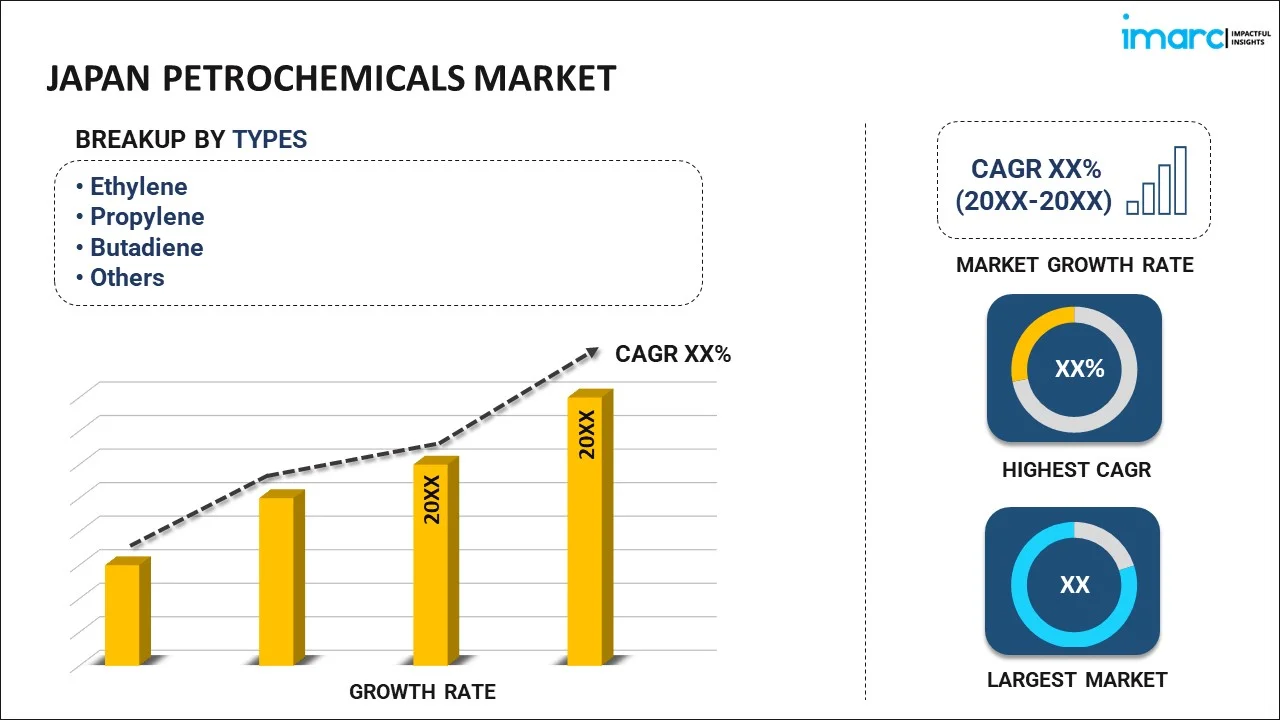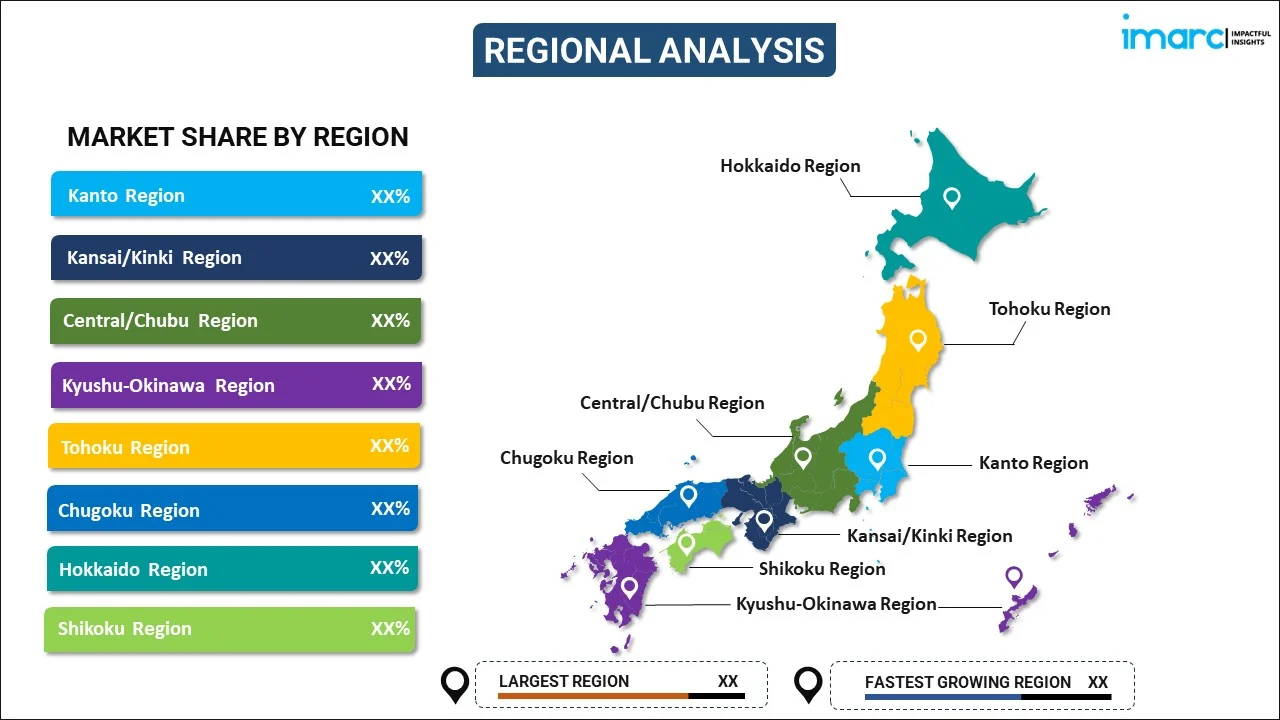
Japan Petrochemicals Market Report by Type (Ethylene, Propylene, Butadiene, Benzene, Toluene, Xylene, Methanol, and Others), Application (Polymers, Paints and Coatings, Solvents, Rubber, Adhesives and Sealants, Surfactants and Dyes, and Others), End Use Industry (Packaging, Automotive and Transportation, Construction, Electrical and Electronics, Healthcare, and Others), and Region 2025-2033
Market Overview:
Japan petrochemicals market size reached 3.60 Million BPD in 2024. Looking forward, IMARC Group expects the market to reach 4.61 Million BPD by 2033, exhibiting a growth rate (CAGR) of 2.66% during 2025-2033. The implementation of stringent environmental regulations and the increasing sustainability concerns among individuals are primarily driving the market growth.
|
Report Attribute
|
Key Statistics
|
|---|---|
|
Base Year
|
2024 |
|
Forecast Years
|
2025-2033 |
|
Historical Years
|
2019-2024
|
| Market Size in 2024 | 3.60 Million BPD |
| Market Forecast in 2033 | 4.61 Million BPD |
| Market Growth Rate (2025-2033) | 2.66% |
Petrochemicals stand as a fundamental element within the contemporary industrial landscape, constituting a diverse collection of chemicals sourced from petroleum or natural gas. These chemicals are primarily manufactured via processes like steam cracking and catalytic cracking, which disassemble hydrocarbons into smaller, more valuable molecules. Petrochemicals boast extensive applicability across a spectrum of industries encompassing plastics, pharmaceuticals, textiles, and agriculture. Their versatility serves as a prominent advantage, facilitating the production of a wide array of products, ranging from plastics and synthetic rubber to solvents and detergents. The role of petrochemicals is pivotal in bolstering economic development, although their production and utilization also raise environmental concerns owing to emissions and waste. Key categories of petrochemicals encompass olefins such as ethylene and propylene, aromatics including benzene and toluene, as well as various intermediates.
Japan Petrochemicals Market Trends:
The petrochemicals market in Japan holds a significant position within the nation's industrial landscape, with a strong focus on innovation, efficiency, and environmental sustainability. Japan's petrochemical industry is built upon the foundation of utilizing petroleum and natural gas as feedstocks to produce a diverse range of chemicals. Additionally, these chemicals serve as integral components in various sectors, including manufacturing, automotive, electronics, and construction. Japan's petrochemical sector places a strong emphasis on technological advancements and process optimization to maximize the value derived from feedstock materials. Besides this, innovative methods such as steam cracking and catalytic cracking are employed to efficiently break down hydrocarbons into valuable chemical components, which is acting as another significant growth-inducing factor. This commitment to technological innovation not only enhances production efficiency but also aligns with Japan's sustainability goals by reducing environmental impacts. Furthermore, the versatility of petrochemical products plays a pivotal role in Japan's manufacturing prowess, enabling the production of plastics, synthetic rubber, textiles, pharmaceuticals, and a wide array of industrial chemicals. In summary, Japan's petrochemicals market represents a dynamic and vital component of the nation's industrial ecosystem, which is anticipated to fuel the regional market over the forecasted period.
Japan Petrochemicals Market Segmentation:
IMARC Group provides an analysis of the key trends in each segment of the market, along with forecasts at the country level for 2025-2033. Our report has categorized the market based on type, application, and end use industry.
Type Insights:

- Ethylene
- Propylene
- Butadiene
- Benzene
- Toluene
- Xylene
- Methanol
- Others
The report has provided a detailed breakup and analysis of the market based on the type. This includes ethylene, propylene, butadiene, benzene, toluene, xylene, methanol, and others.
Application Insights:
- Polymers
- Paints and Coatings
- Solvents
- Rubber
- Adhesives and Sealants
- Surfactants and Dyes
- Others
A detailed breakup and analysis of the market based on the application have also been provided in the report. This includes polymers, paints and coatings, solvents, rubber, adhesives and sealants, surfactants and dyes, and others.
End Use Industry Insights:
- Packaging
- Automotive and Transportation
- Construction
- Electrical and Electronics
- Healthcare
- Others
The report has provided a detailed breakup and analysis of the market based on the end use industry. This includes packaging, automotive and transportation, construction, electrical and electronics, healthcare, and others.
Regional Insights:

- Kanto Region
- Kansai/Kinki Region
- Central/ Chubu Region
- Kyushu-Okinawa Region
- Tohoku Region
- Chugoku Region
- Hokkaido Region
- Shikoku Region
The report has also provided a comprehensive analysis of all the major regional markets, which include Kanto Region, Kansai/Kinki Region, Central/ Chubu Region, Kyushu-Okinawa Region, Tohoku Region, Chugoku Region, Hokkaido Region, and Shikoku Region.
Competitive Landscape:
The market research report has also provided a comprehensive analysis of the competitive landscape. Competitive analysis such as market structure, key player positioning, top winning strategies, competitive dashboard, and company evaluation quadrant has been covered in the report. Also, detailed profiles of all major companies have been provided. Some of the key players include:
- BASF SE
- Hanwha TotalEnergies Petrochemical Co. Ltd.
- Shell plc
- Sumitomo Chemical Co. Ltd.
(Please note that this is only a partial list of the key players, and the complete list is provided in the report.)
Japan Petrochemicals Market Report Coverage:
| Report Features | Details |
|---|---|
| Base Year of the Analysis | 2024 |
| Historical Period | 2019-2024 |
| Forecast Period | 2025-2033 |
| Units | Million BPD |
| Scope of the Report | Exploration of Historical and Forecast Trends, Industry Catalysts and Challenges, Segment-Wise Historical and Predictive Market Assessment:
|
| Types Covered | Ethylene, Propylene, Butadiene, Benzene, Toluene, Xylene, Methanol, Others |
| Applications Covered | Polymers, Paints and Coatings, Solvents, Rubber, Adhesives and Sealants, Surfactants and Dyes, Others |
| End Use Industries Covered | Packaging, Automotive and Transportation, Construction, Electrical and Electronics, Healthcare, Others |
| Regions Covered | Kanto Region, Kansai/Kinki Region, Central/ Chubu Region, Kyushu-Okinawa Region, Tohoku Region, Chugoku Region, Hokkaido Region, Shikoku Region |
| Companies Covered | BASF SE, Hanwha TotalEnergies Petrochemical Co. Ltd., Shell plc, Sumitomo Chemical Co. Ltd., etc. |
| Customization Scope | 10% Free Customization |
| Post-Sale Analyst Support | 10-12 Weeks |
| Delivery Format | PDF and Excel through Email (We can also provide the editable version of the report in PPT/Word format on special request) |
Key Questions Answered in This Report:
- How has the Japan petrochemicals market performed so far and how will it perform in the coming years?
- What has been the impact of COVID-19 on the Japan petrochemicals market?
- What is the breakup of the Japan petrochemicals market on the basis of type?
- What is the breakup of the Japan petrochemicals market on the basis of application?
- What is the breakup of the Japan petrochemicals market on the basis of end use industry?
- What are the various stages in the value chain of the Japan petrochemicals market?
- What are the key driving factors and challenges in the Japan petrochemicals?
- What is the structure of the Japan petrochemicals market and who are the key players?
- What is the degree of competition in the Japan petrochemicals market?
Key Benefits for Stakeholders:
- IMARC’s industry report offers a comprehensive quantitative analysis of various market segments, historical and current market trends, market forecasts, and dynamics of the Japan petrochemicals market from 2019-2033.
- The research report provides the latest information on the market drivers, challenges, and opportunities in the Japan petrochemicals market.
- Porter's five forces analysis assist stakeholders in assessing the impact of new entrants, competitive rivalry, supplier power, buyer power, and the threat of substitution. It helps stakeholders to analyze the level of competition within the Japan petrochemicals industry and its attractiveness.
- Competitive landscape allows stakeholders to understand their competitive environment and provides an insight into the current positions of key players in the market.
Need more help?
- Speak to our experienced analysts for insights on the current market scenarios.
- Include additional segments and countries to customize the report as per your requirement.
- Gain an unparalleled competitive advantage in your domain by understanding how to utilize the report and positively impacting your operations and revenue.
- For further assistance, please connect with our analysts.
 Inquire Before Buying
Inquire Before Buying
 Speak to an Analyst
Speak to an Analyst
 Request Brochure
Request Brochure
 Request Customization
Request Customization




.webp)




.webp)












